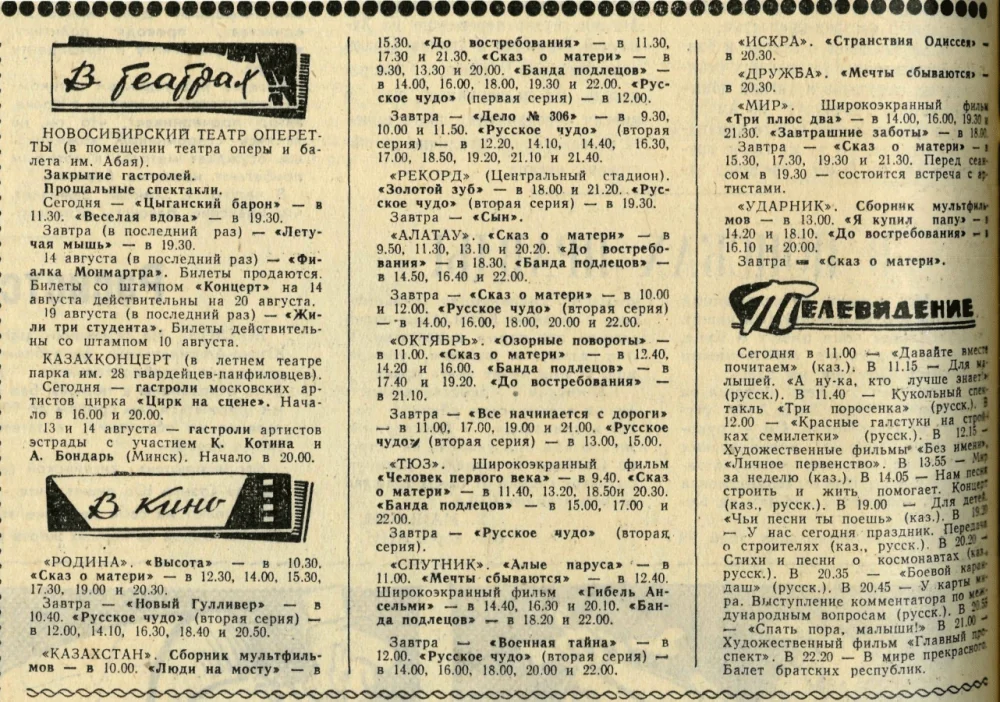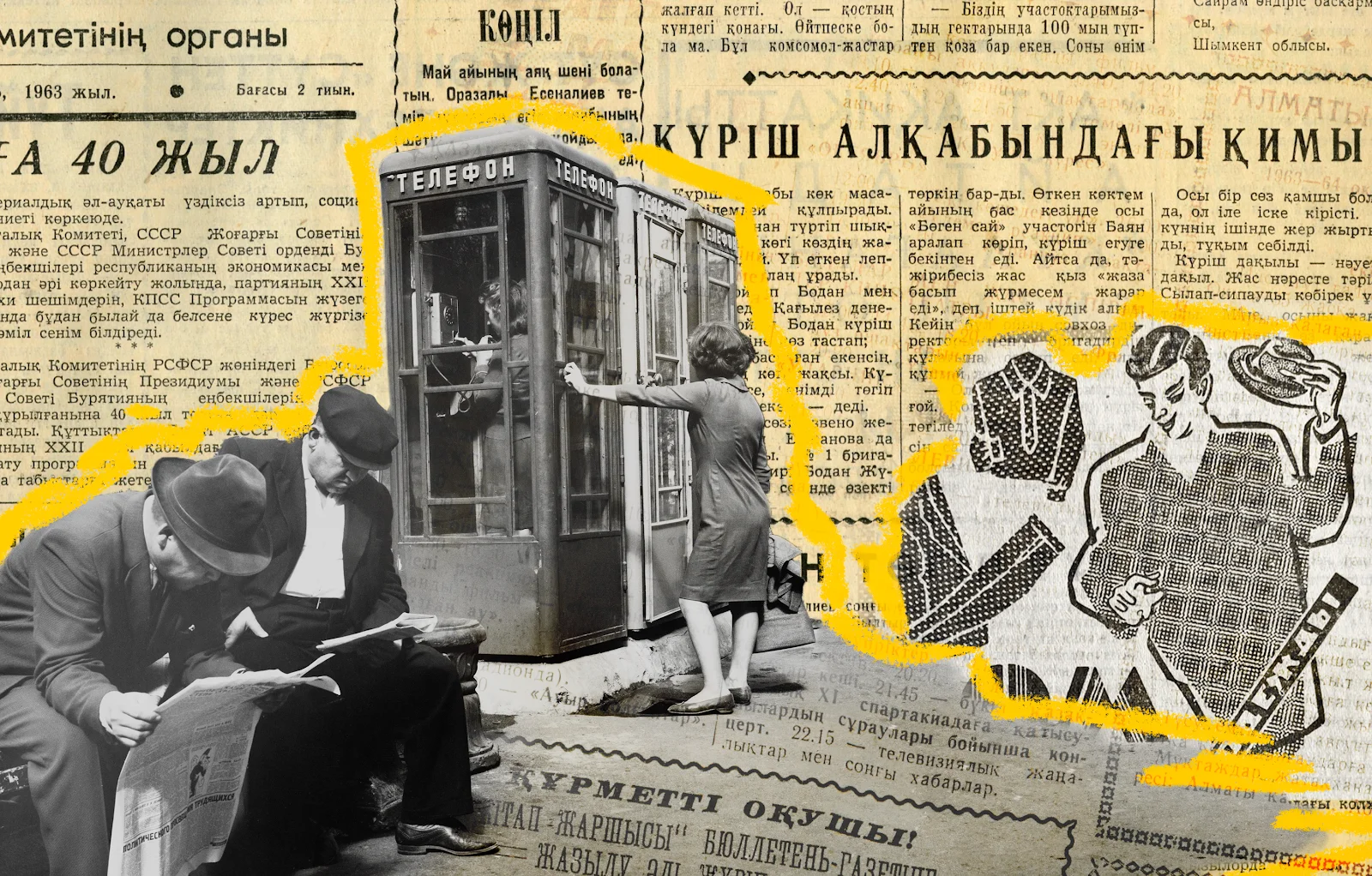Why did Soviet newspapers go all in on a US plane crash but barely mention a deadly mudflow in Kazakhstan? What was everyday life really like in the Soviet Union—what did people watch at the movies, how much would a coat set you back by, and why was getting a divorce a public spectacle?
We delved into the headlines from that time and gathered compelling clippings that reveal more about daily life in the USSR of 1963 than any history book ever could.
A Focus on International Events
In early July 1963, several Kazakh newspapers ran articles in Russian and Kazakh about an American jet that had crashed into a children’s summer camp in Pennsylvania. The crash occurred on 7 July, which was the same day as the devastating mudflow at Lake Issyk near Almaty. Yet, the latter received almost no coverage at the time. The first article addressing it appeared only two weeks later, but rather than being a hard-hitting news piece, it was more explanatory, and almost academic, in its approach.
Such selective attention to local news was typical of the era: international events were prioritized, especially those in countries with which the Soviet Union was ideologically opposed.
It was the height of the Cold War, the confrontation between the USSR and the USA that began in 1946 and lasted until the fall of the Berlin Wall in 1989. One of the flashpoints of this conflict was Cuba, where a revolution took place in 1959. Soviet newspapers devoted extensive coverage to news from the ‘Island of Freedom’.
Another conflict that received more than just passing mention was the Sino-Soviet split, which began in the late 1950s. It was widely reported, often taking up entire pages in newspapers, and eventually caused deep divisions within the global communist movement. In addition to coverage of the US, Cuba, and China, Soviet newspapers also devoted significant attention and space to African countries, which the Soviet Union was actively supporting during that period.
Goods on Credit and Soviet Advertising
One of the defining features of the Soviet era was the constant ‘shortage’ of goods. It was impossible to simply walk into a store or market and buy everything you needed at one go. Quality goods had to be ‘hunted down’, often requiring you to stand in line for hours. In some cases, such goods could be purchased on credit. The average monthly salary in the 1960s was around 80 rubles. A coat typically cost about 100 rubles, a radio receiver ranged from 50 to 150 rubles, and a bicycle went for about 70 rubles. For comparison: a kilogram of beef cost about 2 rubles, a loaf of bread 16 kopecks, and a movie ticket 25 kopecksi
Divorce Announcements
From the 1930s to the mid-1960s, getting a divorce in the Soviet Union was not only a public but also often a humiliating ordeal. The process required a formal announcement in the local newspaper, and the initiator had to justify their decision in court. These bureaucratic hurdles and awkward formalities were deliberately designed by Soviet authorities to discourage citizens from ending their marriages.

Divorce announcements – on the last pages of the «Ogni Alatau» newspaper / National Library of the Republic of Kazakhstan
The divorce procedure was slightly simplified two years later, when on 10 December 1965, the Presidium of the Supreme Soviet of the USSR issued Decree No. 4238-VI, titled ‘On Certain Changes to the Procedure for Handling Divorce Cases in Courts’. The new rules reduced the number of required court hearings, eliminated mandatory newspaper announcements of divorce proceedings, and streamlined paperwork for uncontested cases. These changes meant fewer bureaucratic hurdles and shorter waiting periods, which were small but meaningful changes in a system that traditionally made divorce difficult.
Posters and Job Listings
In the early 1960s, televisions were still a rare luxury, costing between 250 and 400 rubles. They could typically be found in the homes of Party officials or in cultural centers. As a result, TV programming was quite limited and was often printed in newspapers.

Theater listings, film posters, and TV schedules were most often published on a single page / National Library of the Republic of Kazakhstan
Going to the movies, however, was one of the most popular pastimes at the time, with theaters showing both new films and beloved classics from the past. The standout film of the summer of 1963, frequently featured in newspapers, was the two-part documentary The Russian Miracle, made by German filmmakers. It traced the rise of socialism, starting with the Russian Empire and ending with Yuri Gagarin’s historic spaceflight in 1961.
Among the older films that would play regularly included The Three Musketeers, a 1961 Franco-Italian production, and the Soviet adventure comedy Polisatyi Reis (Striped Voyage), which was also released in 1961.
Among the job listings found in the newspapers in 1963, the most common vacancies were for engineers of various specializations, construction workers, welders, and a profession quite rare in today’s world, a normirovshchik, or a specialist responsible for defining, setting, and monitoring labor standards and norms in production.
Sometimes, there were also announcements for more creative and unusual vacancies. For example, one newspaper carried an advertisement reading: ‘Open positions for two young male leads and two young female leads, travestyi
This article includes excerpts from the July 1963 editions of the newspapers Leninshil Jas (Leninist Youth), Socialistik Qazaqstan (Socialist Kazakhstan), Kazakhstanskaia Pravda, Ognï Alataw (Fire of Alatau), and Leninskaia Smena.




